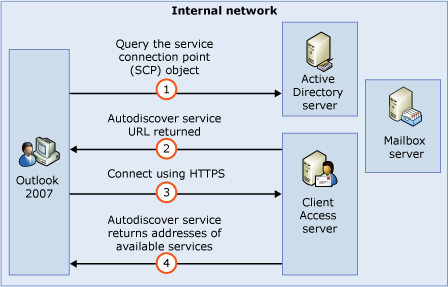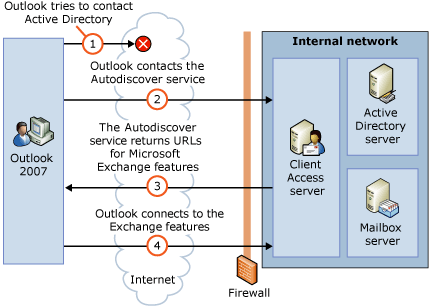Applies to: Exchange Server 2007 SP3, Exchange Server
2007 SP2, Exchange Server 2007 SP1, Exchange Server 2007
Topic Last Modified: 2007-07-27
Microsoft Exchange Server 2007 includes a new Microsoft Exchange service named the Autodiscover service. The Autodiscover service configures client computers that are running Microsoft Office Outlook 2007. The Autodiscover service can also configure supported mobile devices. The Autodiscover service provides access to Microsoft Exchange features for Outlook 2007 clients that are connected to your Microsoft Exchange messaging environment. The Autodiscover service must be deployed and configured correctly for Outlook 2007 clients to automatically connect to Microsoft Exchange features, such as the offline address book, the Availability service, and Unified Messaging (UM). Additionally, these Exchange features must be configured correctly to provide their respective functionality for Outlook 2007 clients. For more information, see How to Configure Exchange Services for the Autodiscover Service.
The Autodiscover service uses a user's e-mail address and
password to provide profile settings to
Outlook 2007 clients and supported mobile devices. If the
Outlook 2007 client is joined to the domain, the user's
domain account is used.
 Note: Note: |
|---|
| The Autodiscover service is available for Outlook 2007 clients and some mobile devices. Earlier versions of Outlook, including Microsoft Outlook 2003, cannot use the Autodiscover service. |
 Outlook 2007 and
Autodiscover
Outlook 2007 and
Autodiscover
The Autodiscover service makes it easier to configure Outlook 2007. Earlier versions of Exchange and Outlook required you to configure all user profiles manually to access Microsoft Exchange. Extra work was required to manage these profiles if changes occurred to the messaging environment. Otherwise, the Outlook clients would stop functioning correctly.
The Autodiscover service uses a user's e-mail address or domain account to automatically configure a user's profile. By using the e-mail address or domain account, the Autodiscover service provides the following information to the client:
- The user’s display name
- Separate connection settings for internal and external
connectivity
- The location of the user’s Mailbox server
- The URLs for various Outlook features that govern
such functionality as free/busy information, Unified Messaging, and
the offline address book
- Outlook Anywhere server settings
When a user's Microsoft Exchange information is changed, Outlook automatically reconfigures the user's profile by using the Autodiscover service. For example, if a user's mailbox is moved or the client is unable to connect to the user's mailbox or to available Exchange features, Outlook will contact the Autodiscover service and automatically update the user's profile to have the information that is required to connect to the mailbox and Exchange features.
The following sections provide information that you must have to successfully deploy the Autodiscover service for your organization.
 How the Autodiscover Service
Works
How the Autodiscover Service
Works
When you install the Client Access server role on a computer that is running Exchange 2007, a new virtual directory named Autodiscover is created under the default Web site in Internet Information Services (IIS). This virtual directory handles Autodiscover service requests from Outlook 2007 clients and supported mobile devices in the following circumstances:
- When a new user account is configured or updated.
- When a user periodically checks for changes to the
Exchange Web Services URLs.
- When underlying network connection changes occur in your
Exchange messaging environment.
Additionally, a new Active Directory object named the service connection point (SCP) is created when you install the Client Access server role.
The SCP object contains the authoritative list of Autodiscover service URLs for the forest. You can update the SCP object by using the Set-ClientAccessServer cmdlet. For more information about the Set-ClientAccessServer cmdlet, see Set-ClientAccessServer.
 Important: Important: |
|---|
| Before you save the new Active Directory object, make sure that the Authenticated Users account has Read permissions for the SCP object. If users do not have the correct permissions, they will be unable to search for and read items. |
For more information about SCP objects, see Publishing with Service Connection Points.
Figure 1 illustrates how a client connects to a Client Access server the first time from inside the internal network.

For external access, the client locates the Autodiscover service on the Internet by using the primary SMTP domain address from the user's e-mail address.
 Note: Note: |
|---|
| You must provide a host record for the Autodiscover service for external DNS. |
Depending on whether you have configured the Autodiscover service on a separate site, the Autodiscover service URL will be either https://<smtp-address-domain>/autodiscover/autodiscover.xml or https://autodiscover.<smtp-address-domain>/autodiscover/autodiscover.xml. Figure 2 illustrates a simple topology with a client connecting from the Internet.
Figure 2 The Autodiscover service process for external access

When the client connects to the Active Directory directory service, the client looks for the SCP object that was created during Setup. In deployments that include multiple Client Access servers, an Autodiscover SCP object is created for each Client Access server. The SCP object contains the ServiceBindingInfo attribute that has the FQDN of the Client Access server in the form of https://CAS01/autodiscover/autodiscover.xml, where CAS01 is the FQDN for the Client Access server. By using the user credentials, the Outlook 2007 client authenticates to Active Directory and searches for the Autodiscover SCP objects. After the client obtains and enumerates the instances of the Autodiscover service, the client connects to the first Client Access server in the enumerated list and obtains the profile information in the form of XML data that is needed to connect to the user's mailbox and available Microsoft Exchange features.
 Deployment Options for the
Autodiscover Service
Deployment Options for the
Autodiscover Service
Deploying the Autodiscover service is only one step in making sure that your Microsoft Exchange services, such as the Availability service, can be accessed by Outlook 2007 clients. These services must be deployed and configured correctly for clients to receive the correct profile configuration information from the Autodiscover service. For more information about how to deploy your Microsoft Exchange services, see How to Configure Exchange Services for the Autodiscover Service.
We recommend that you consider how to deploy the Autodiscover service when you plan the Client Access server infrastructure for your Exchange messaging environment. For more information about how to deploy the Autodiscover service, see Deployment Considerations for the Autodiscover Service.
 For More Information
For More Information
For more information about how to deploy and manage the Autodiscover service, see the following topics:

